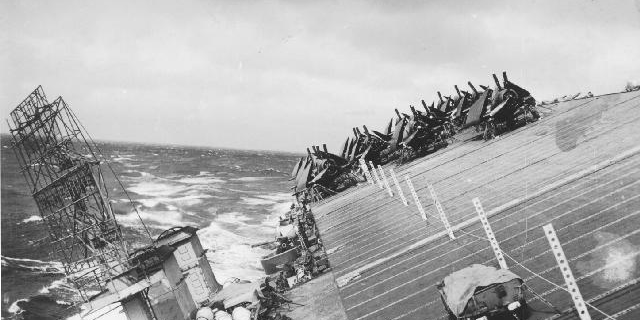The First Kamikaze Attacks 80 Years Ago Today
Contributor: Barry Fetzer
Sources: Wikipedia, Military Officer Magazine
According to Wikipedia, “In desperation during the last years of WWII, the Japanese developed the concept of formally organized suicide units. Suicide attacks, beginning 80 years ago today in 1944, followed critical military and strategic defeats for Japan. These attacks also followed Japan’s decreasing capacity to wage war (including the loss of experienced pilots), the increasing industrial might of the allies (especially the United States), and reflected Japan’s “Bushido tradition” or “way of the warrior” which, amongst other qualities, included a reluctance to surrender.
“In Japanese, the formal term used for units carrying out suicide attacks during 1944-45 is tokubetsu kōgeki tai, which literally means ‘special attack unit’. More specifically, air suicide attack units from the Imperial Japanese Navy were officially called shinpū tokubetsu kōgeki tai (‘divine wind special attack units’). Shinpū is the Chinese-derived pronunciation of the same characters that form the word Kamikaze in Japanese. During World War II, the actual word Kamikaze was rarely used in Japan in relation to suicide attacks. US translators during the war erroneously used the kun’yomi (indigenous Japanese pronunciation) for Shinpū, giving the English language the word Kamikaze for Japanese suicide units in general. This usage gained acceptance worldwide. After the war, Japanese speakers re-imported both the word and the English language pronunciation under the influence of US media sources. As a result, the special attack units are sometimes known in Japan today as kamikaze tokubetsu kōgeki tai.

A painting of Shizu, better known as Kublai Khan, Mongolian emperor of the Yuan Dynasty. Courtesy Wikipedia
“Kamikaze or ‘Divine Wind’ units were named as such to commemorate great typhoons that dispersed fleets of 4,400 Kublai Khan-led Mongol ships that sank off of the coast of Takashima during ill-fated missions to occupy Japan in 1274 and 1281 during the Middle Ages, saving the Japanese Kingdom from attack and destruction. Knowing this history, the US Army Air Corps developed weather forecasting systems to help forecast typhoons, which like the divine winds of the Middle Ages, might endanger the attacking Allied fleet.”
The Allies had reason to worry, and not just from Middle-age history and legend. Not only would the planned assault on the Japanese main islands to end WWII result in horrific losses for the Allies—particularly the U.S.—and the Japanese people themselves as well as their infrastructure, but should another “Divine Wind” typhoon occur during the final assault on the main Japanese islands, horrific losses could occur to the attacking fleets just as they had to the Mongol “hordes” some seven-hundred years earlier.
“On December 18, 1944, Task Force 38 of U.S. Pacific Fleet commanded by Admiral ‘Bull” Halsey’…sailed directly into the teeth of Typhoon Cobra, a vicious Category 4 tropical cyclone with sustained winds of 140 MPH. At the time of the incident, Task Force 38 has been in the Philippine Sea conducting air raids on Japanese airfields in the Philippines in support of Army General Douglas MacArthur’s ground forces. Unaware of the size, path and intensity of the approaching tropical storm, the fleet was in the process of refueling its ships when the wind picked up and the sea started to churn.”

A “Divine Wind” damages ships from Task Force 38 during WWII. This is the USS Cowpens during Typhoon Cobra, 18 December 1944. Nicknamed the “Mighty Moo”, the USS Cowpens (CV-25), was an 11,000-ton Independence-class light aircraft carrier that served the United States Navy from 1943 to 1947. Courtesy Wikipedia and the US Navy.
“What followed was one of the worst catastrophes in U.S. naval history. Three destroyers—USS Hull (DD-350), USS Spence (DD-512), and USS Monaghan (DD-354)—capsized and sank; a cruiser, five aircraft carriers, and three destroyers were seriously damaged; a total of 146 planes were lost or damaged beyond repair and approximately 790 officers and men were lost or killed.”
(Above two paragraphs quoted from Dan Vaughan, Military Officer Magazine, July 2014, page 60).
Onward and upward!
Sources: US Navy, Wikipedia, Military Officer Magazine







